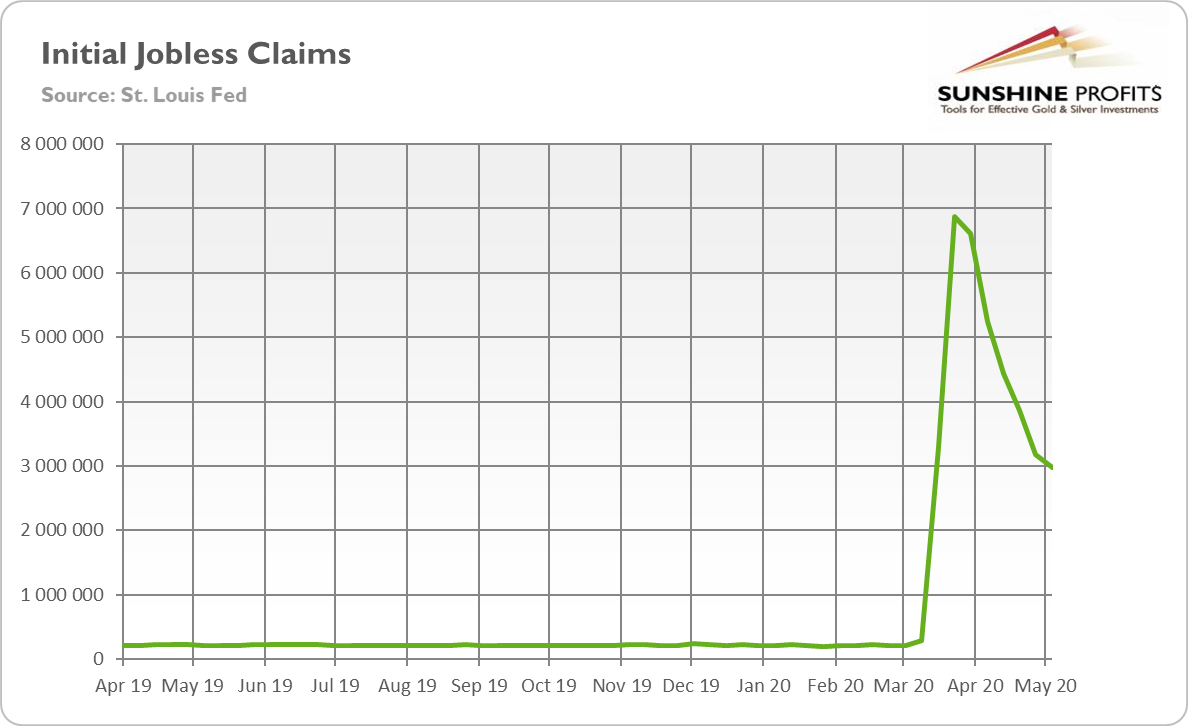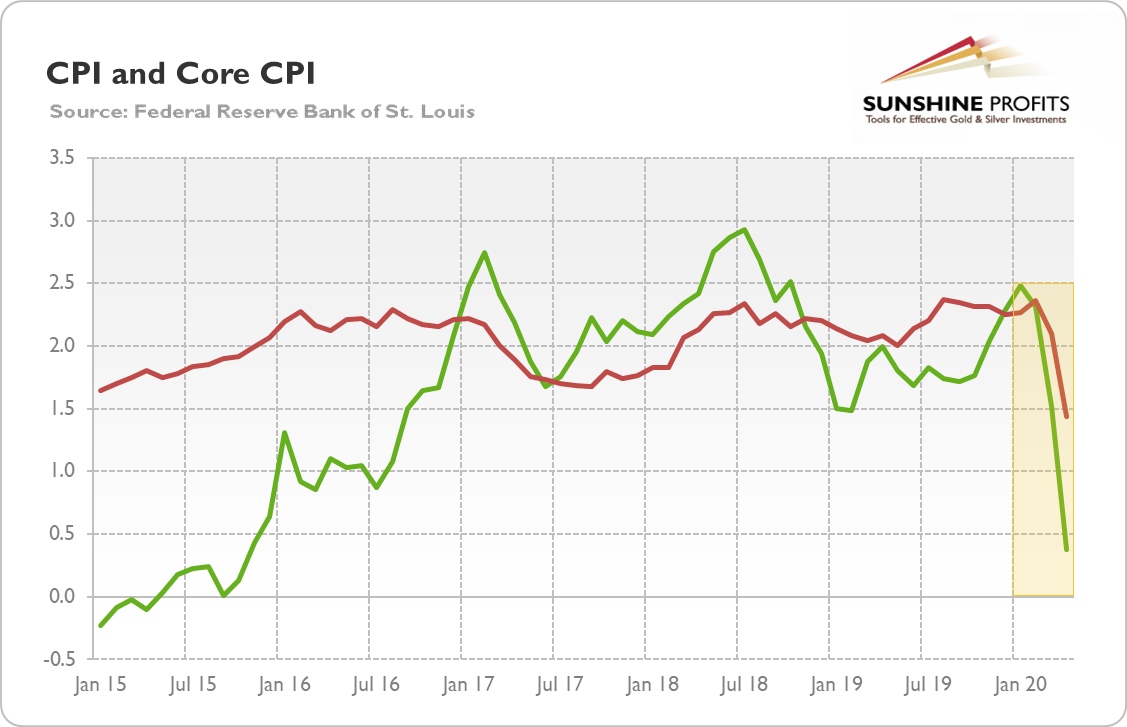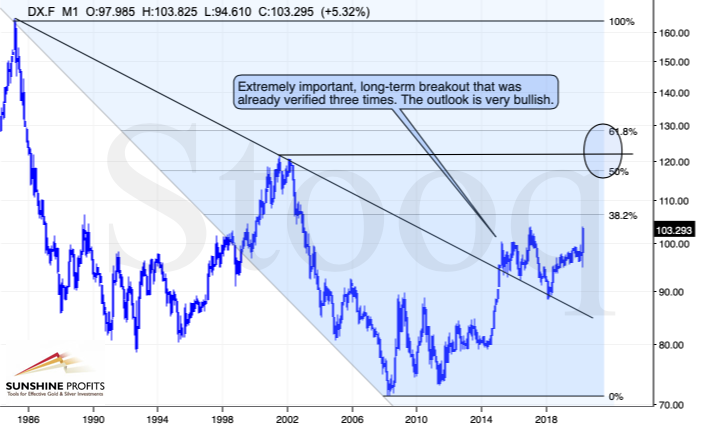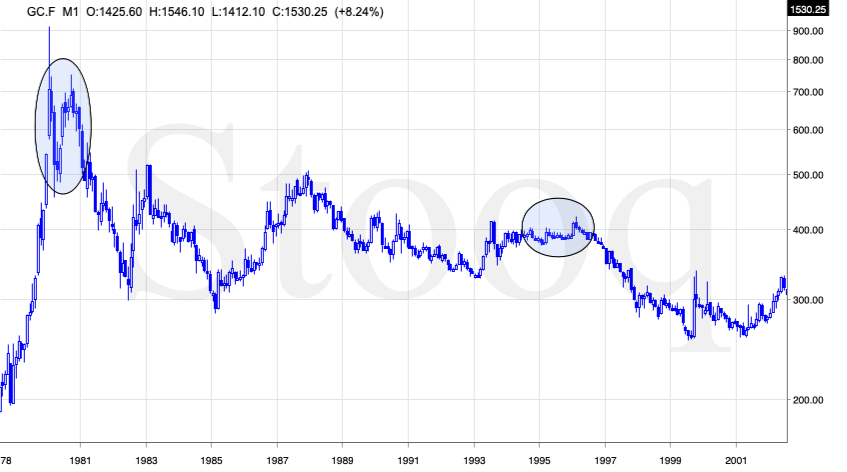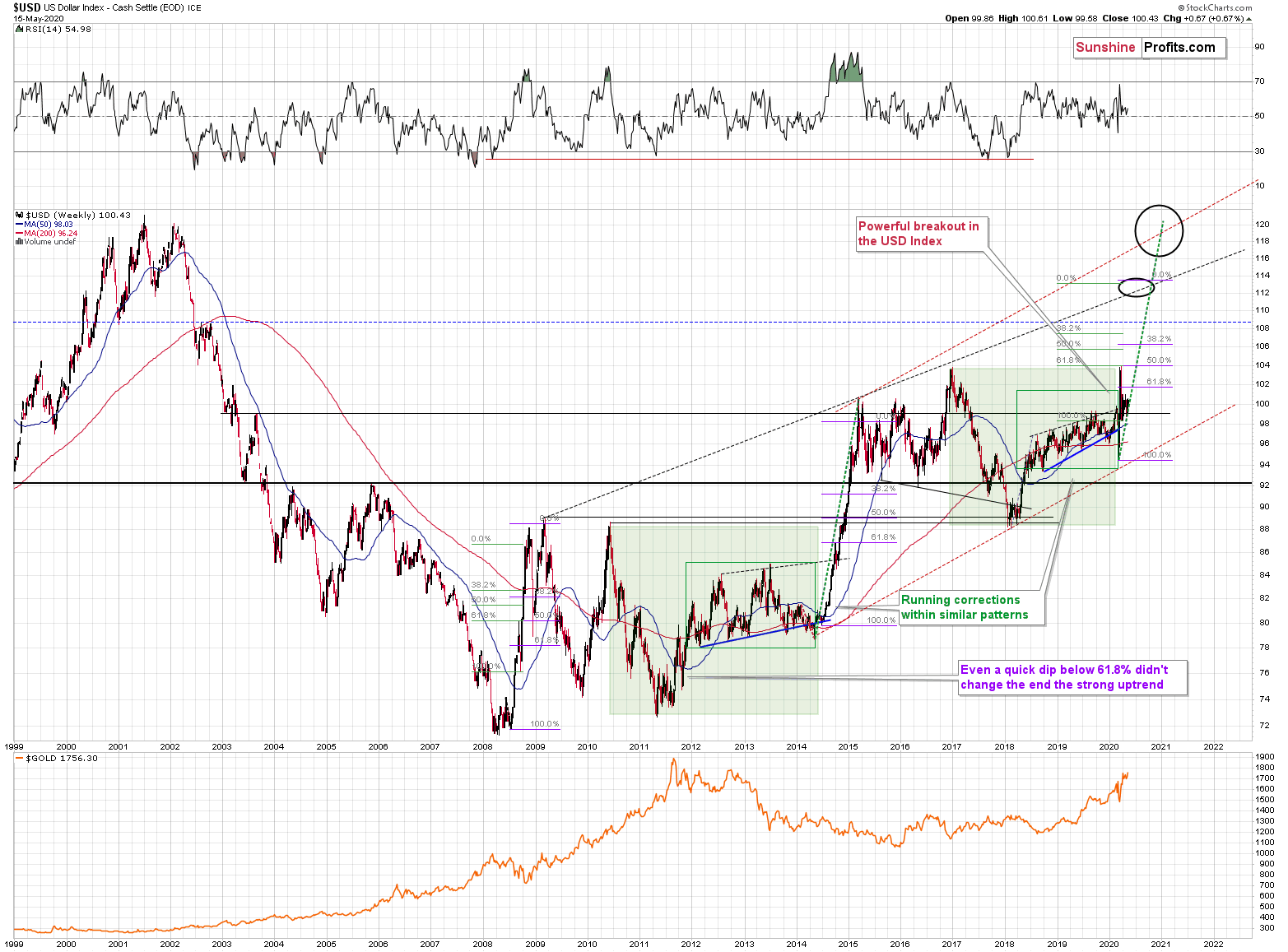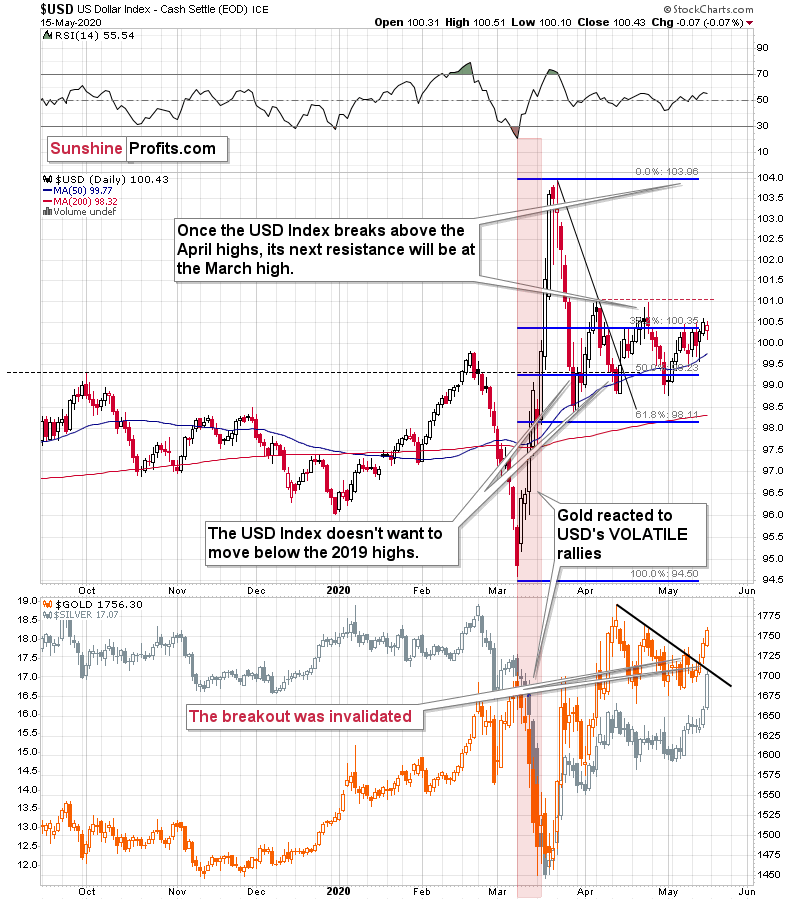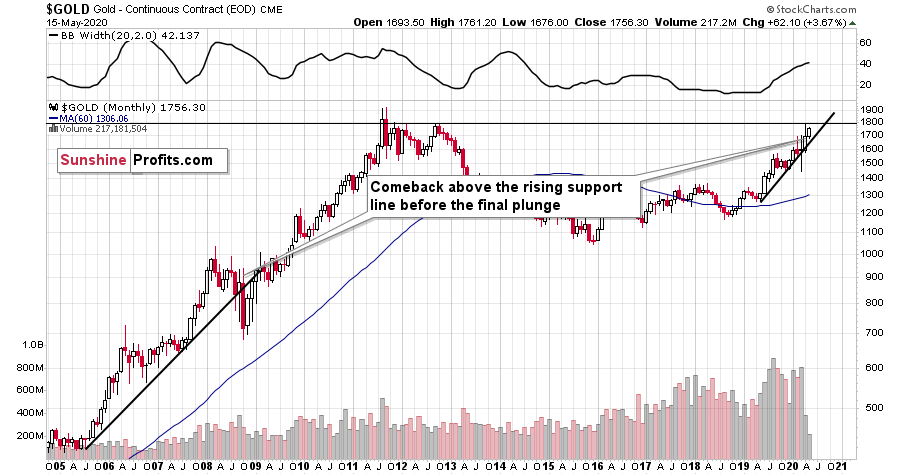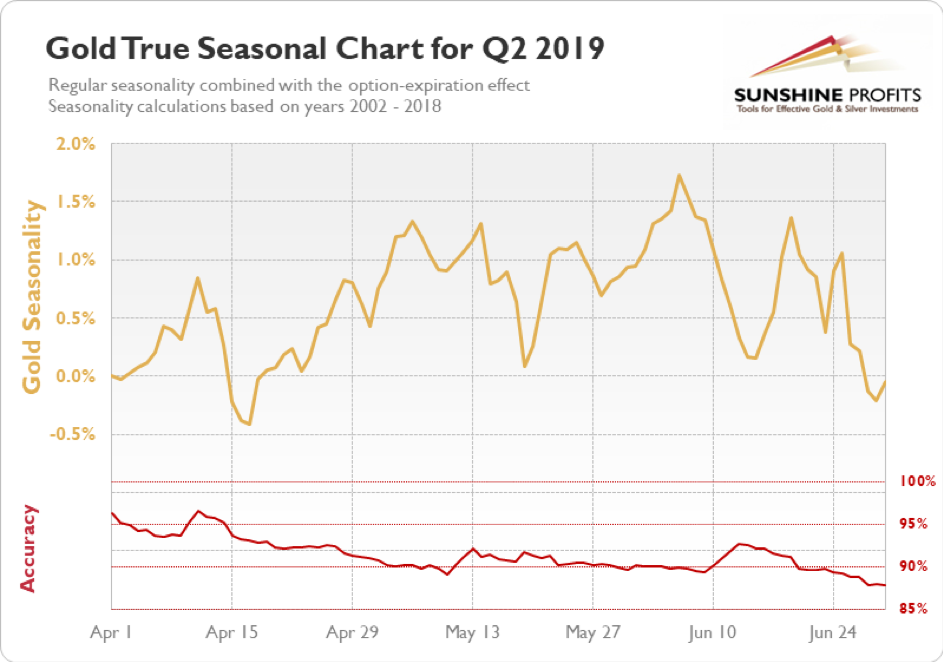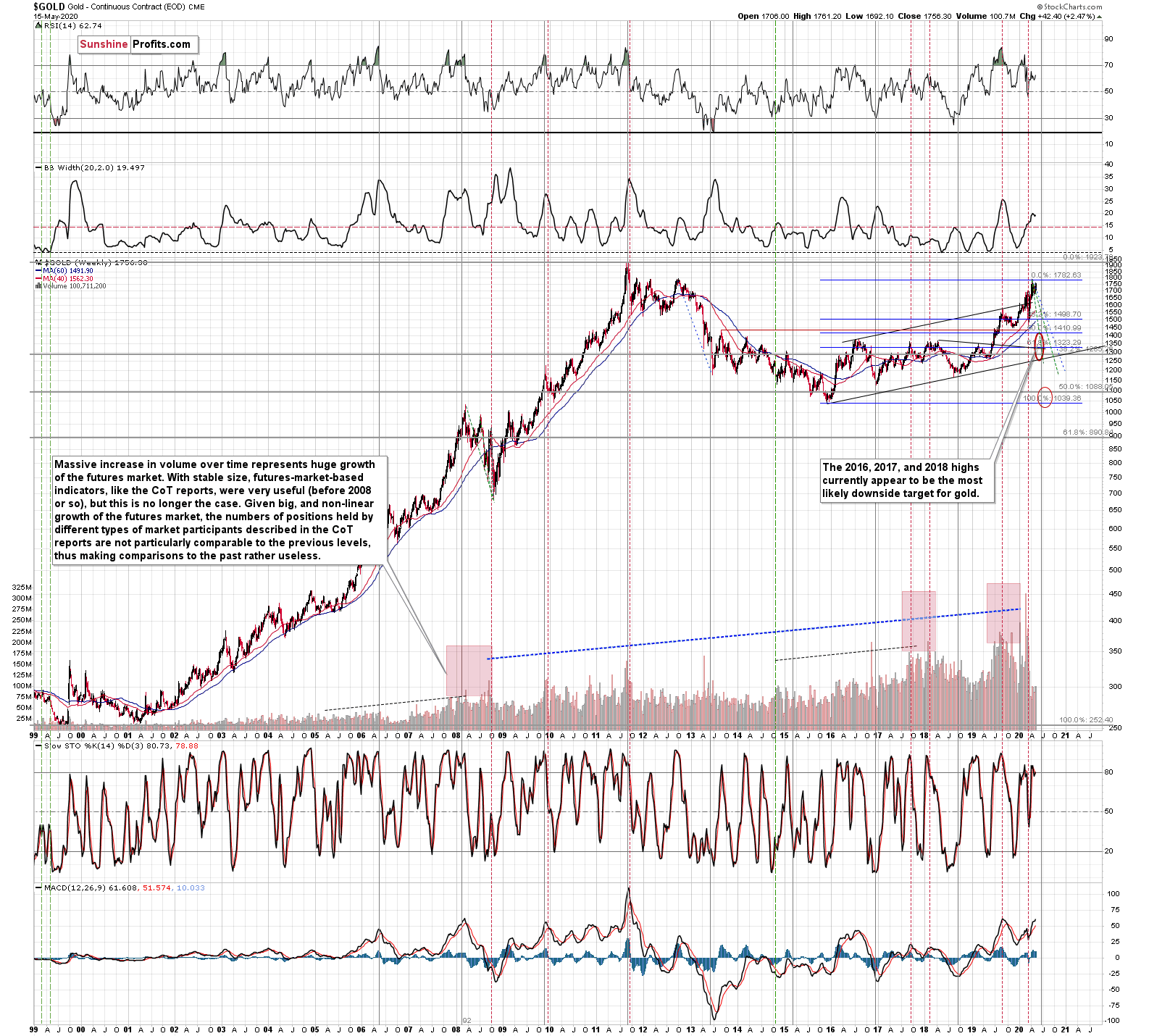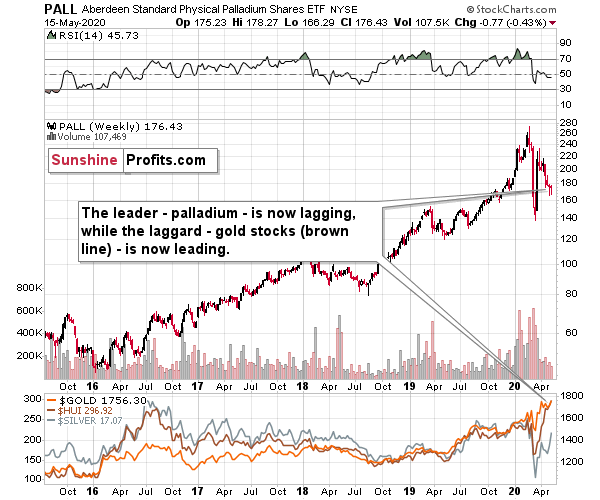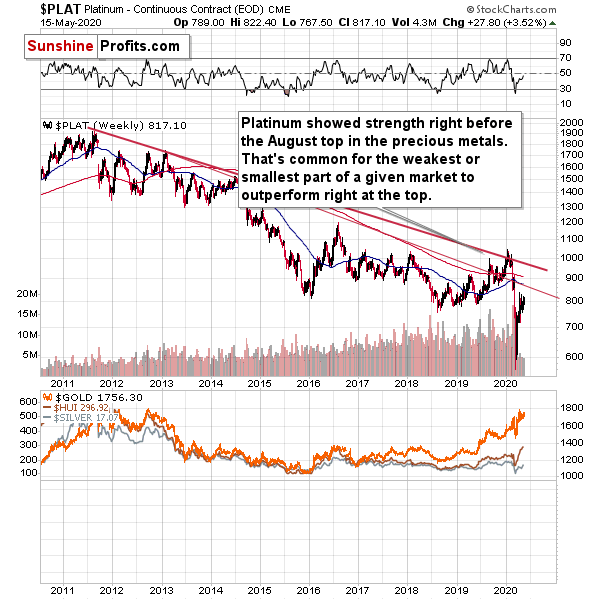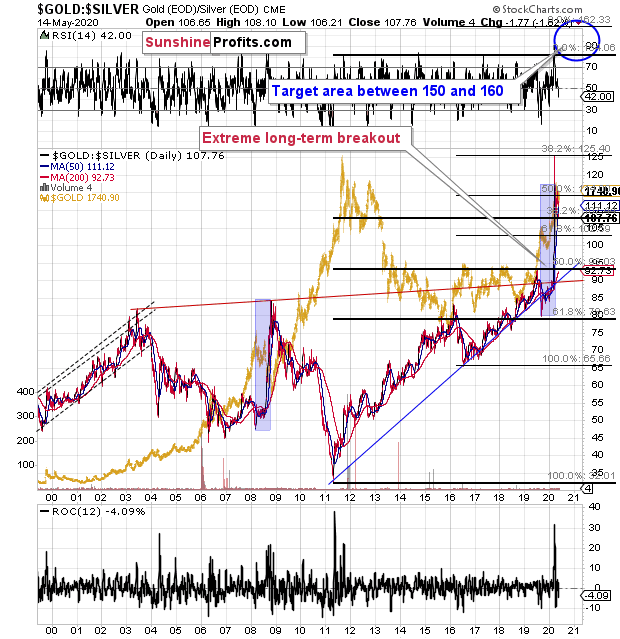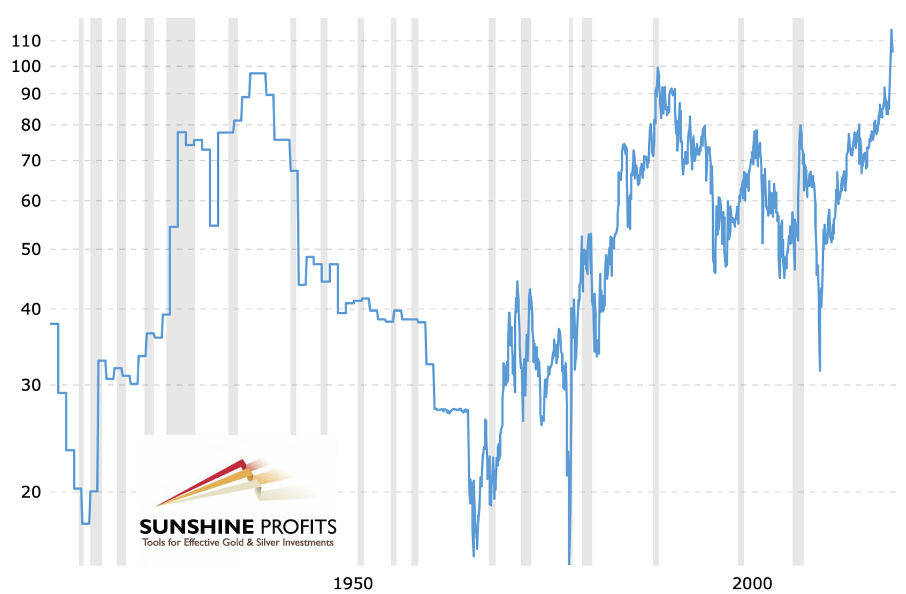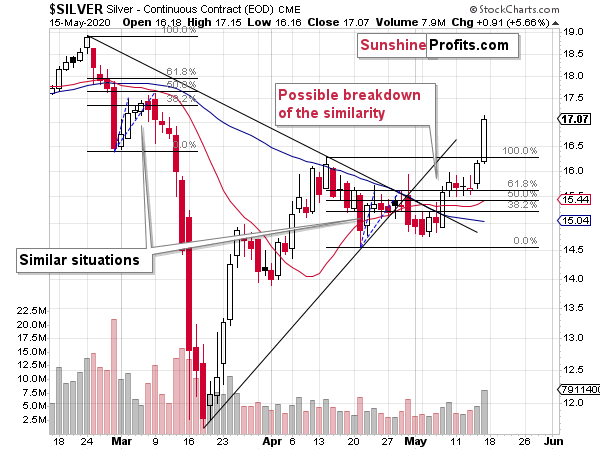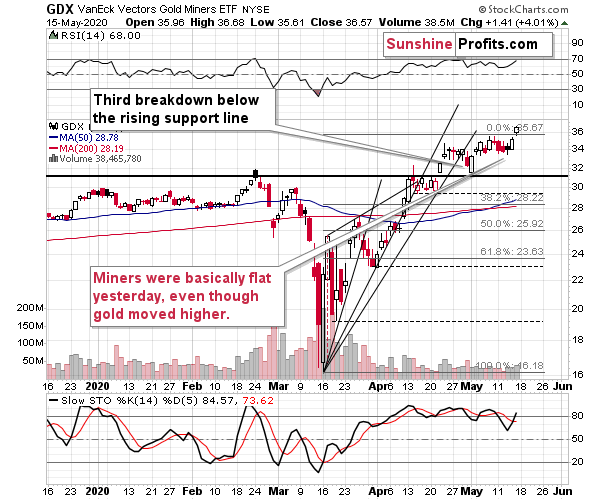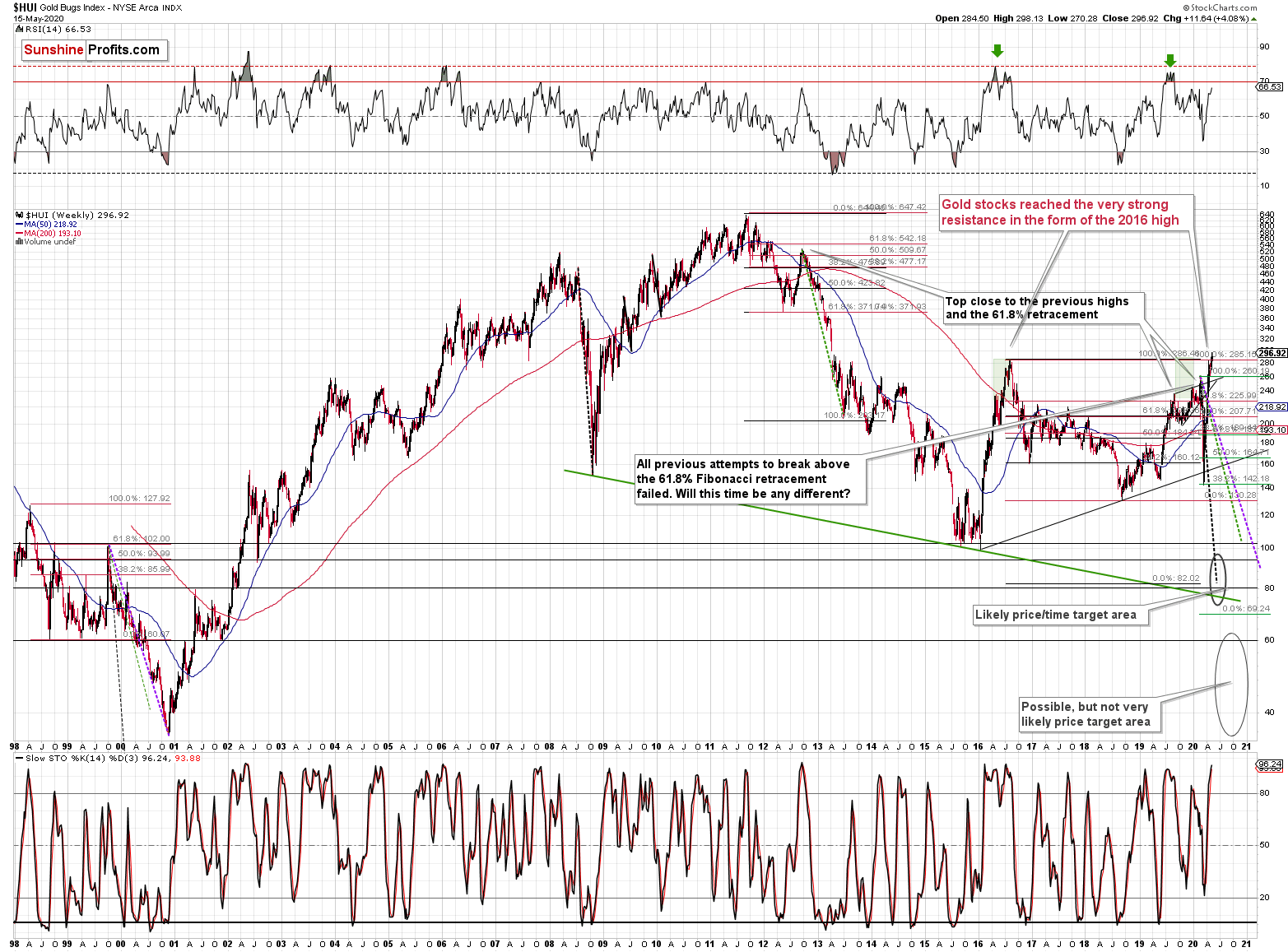Briefly: in our opinion, full (150% of the regular position size) speculative short positions in mining stocks are justified from the risk/reward point of view at the moment of publishing this Alert.
Welcome to this week's flagship Gold & Silver Trading Alert. As we promised you previously, in our flagship Alerts, we will be providing you with bigger, more complex analyses (approximately once per week) and it will usually take place on Monday.
Some of the most important analogies and long-term trends might have changed, but it's too early to say so, and most of our previous extensive comments still remain up-to-date in general.
As it is the case usually, we will quote last week's comments while updating everything that needs to be updated or changed. In the end, the entire below analysis is up-to-date at the moment of publishing. The parts that we didn't change (or changed only insignificantly) since last week, will be put in italics.
The most important fundamental factor right now remains the Covid-19 pandemic and what might be referred to as the Great Lockdown. The total US death count is about 90k, greatly exceeding the regular flu season deaths, and the death toll is quickly climbing in the UK (about 35k deaths) and - most rapidly - in the emerging / BRIC economies. New daily cases in Russia are now regularly about 10k per day, they are between 7k and 12k in Brazil, and in India they are about 5k daily, and still growing. The sum of these three countries' new daily cases is now bigger than the US daily increase in Covid-19 cases. The new daily cases in Pakistan, Bangladesh, and Mexico are also soaring. The pandemic is not over and neither is the Great Lockdown. Let's examine the situation in the job market and in case of inflation.
True Pandemonium Emerges in the US Labor Market
This week was full of economic data. Let's analyze them, starting, as usual, from the initial jobless claims, which became one of the most carefully studied indicator during the coronavirus crisis. As the chart below shows, in the week from May 2 to May 9, three millions of Americans applied for unemployment benefits.
It implies two important things. First, the total number of people who applied for unemployment benefits surpassed 36 million in the United States. It means that the implied naïve unemployment rate (which assumes no dropouts from the labor market) is almost 35 percent. Yes, you read it correctly: about one third of Americans belonging to the labor force is without job. The real unemployment rate is lower, of course, as some people dropped out from the job market, but, on the other hand, lots of states are still underreporting new unemployment claims as they cannot handle the crush of applications. Anyway, the number is probably higher than during the Great Depression!
Second, although the new initial claims are going to subside as states are reopening their economies, the recovery may be slower than commonly believed. Please look at the chart above once again. Although since the end of March, the number of new claims is on the decline, the US economy still loses several million jobs a week. The number of initial claims reached a peak in just two-three weeks, but six weeks have already passed since the peak and is the pre-pandemic level getting closer in sight?
The current havoc in the US labor market is unprecedented. And what is also unprecedented is the behavior of the stock market, given the ongoing pandemonium. One possible reason might be the hope that the crisis is temporary, which is partially justified. However, it might be also the case that the financial markets are a bit complacent, drugged by the Fed's monetary cocaine. Anyway, gold should get out of crisis strengthened due to the elevated uncertainty, lower real interest rates and higher public debt.
Inflation Rate Drops
And what about inflation? Will we see higher inflation rates? Or lower, as the recent data suggest? The US CPI inflation rate declined 0.8 percent in April, following a 0.4 percent move lower in March. It was the largest monthly decline since December 2008. The decrease was mainly driven by a sharp decline of 20.6 percent in the gasoline prices. However, the core CPI rate, which excludes energy and food prices, also decreased in March - by 0.4 percent (versus 0.1 percent decline in March), as practically all indexes declined, including huge declines in the prices of apparel and transportation services (airline fares posted record drop). The only important exemptions were flat shelter prices, and rising prices of medical care services and food. The drop in the core CPI was the largest monthly decline in the history of the series, which dates to 1957.
On an annual basis, the overall CPI increased 0.3 percent, significantly more than the 1.5 percent rise in March and the 2.3 percent rise in February. It was the smallest 12-month increase since October 2015. The core CPI rose 1.4 percent over the last 12 months, compared to the 2.1 percent increase in the previous month. It was the smallest increase since April 2011. The chart below shows these disinflationary trends.
Importantly, gold prices did not show any weakness due to the lower inflation readings. For some people, it might be surprising - but not for our Readers, who know that gold is not just about inflation versus deflation. The yellow metal is a safe-haven asset which may shine during both inflationary and deflationary periods.
Fundamental Implications for Gold
Does it negate our view that the current crisis could be more inflationary than the Great Recession? Not at all, we actually expected disinflation - we wrote in the Fundamental Gold Report published on April 16 that "in the short term, disinflationary pressure should prevail". So, we never ruled out the possibility of disinflation or even deflation - the disinflationary pressure was obvious for all economists. What we meant and we still mean is that during the current crisis, there are some forces that were absent during the Great Recession. This is perhaps why the disinflationary pressure has been so far weaker than during the global financial crisis and this is why it could consequently cause relatively higher inflation over the medium and long run.
We mean here the quickly rising the supply of credit and of broad money supply. Additionally, the reopening of economies should strengthen the inflationary pressure compared to the lockdown. It should translate into higher prices eventually, which should support the demand for gold as an inflation hedge. However, investors should remember that the increase in the broad money supply affects prices with significant lag of several months, and it might be also be the case that the inflationary pressure will affect the asset prices more or earlier than the CPI Index.
Overall, the fundamental outlook for gold has been, and remains very positive. But the same is the case with regard to the US dollar at least in the short run, as the BRIC / developing countries are entering much worse periods of the pandemic. The above discussion of the labor market is also fundamentally very bearish for the general stock market.
While the above combination of factors is unlikely to prevent gold from rallying in the long- and medium-term, declining stocks and soaring USD Index are likely to trigger declines in gold in the short run - similarly to what they did in March.
Let's start with the reminder about USD's big picture and gold's performance during big upswings in the USD Index.
The Big Picture View of the USD Index
The 2014-2015 rally caused the USD Index to break above the declining very-long-term resistance line, which was verified as support three times. This is a textbook example of a breakout and we can't stress enough how important it is.
The most notable verification was the final one that we saw in 2018. Since the 2018 bottom, the USD Index is moving higher and the consolidation that it's been in for about a year now is just a pause after the very initial part of the likely massive rally that's coming.
If even the Fed and the U.S. President can't make the USD Index decline for long, just imagine how powerful the bulls really are here. The rally is likely to be huge and the short-term (here: several-month long) consolidation may already be over.
There are two cases on the above chart when the USD Index was just starting its massive rallies: in the early 1980s and in mid-90s. What happened in gold at that time?
Gold Performance When the USD Index Soars
These were the starting points of gold's most important declines of the past decades. The second example is much more in tune with the current situation as that's when gold was after years of prolonged consolidation. The early 1980s better compare to what happened after the 2011 top.
Please note that just as what we saw earlier this year, gold initially showed some strength - in February 1996 - by rallying a bit above the previous highs. The USD Index bottomed in April 1995, so there was almost a yearly delay in gold's reaction. But in the end, the USD - gold relationship worked as expected anyway.
The USD's most recent long-term bottom formed in February 2018 and gold seems to have topped right now. This time, it's a bit more than a year of delay, but it's unreasonable to expect just one situation to be repeated to the letter given different economic and geopolitical environments. The situations are not likely to be identical, but they are likely to be similar - and they indeed are.
What happened after the February 1995 top? Gold declined and kept on declining until reaching the final bottom. Only after this bottom was reached, a new powerful bull market started.
Please note that the pace at which gold declined initially after the top - in the first few months - was nothing to call home about. However, after the initial few months, gold's decline visibly accelerated.
Let's compare the sizes of the rallies in the USDX and declines in gold. In the early 80s, the USDX has almost doubled in value, while gold's value was divided by the factor of 3. In the mid-90s, the USDX rallied by about 50% from its lows, while gold's value was divided by almost 1.7. Gold magnified what happened in the USD Index in both cases, if we take into account the starting and ending points of the price moves.
However, one can't forget that the price moves in USD and in gold started at different times - especially in the mid-90s! The USDX bottomed sooner, which means that when gold was topping, the USDX was already after a part of its rally. Consequently, when gold actually declined, it declined based on only part of the slide in the USDX.
So, in order to estimate the real leverage, it would be more appropriate to calculate it in the following way:
- Gold's weekly close at the first week of February 1996: $417.70
- USDX's weekly close at the first week of February 1996: 86.97
- Gold's weekly close at the third week of July 1999: $254.50
- USDX's weekly close at the third week of July 1999: 103.88
The USD Index gained 19.44%
Gold lost 39.07% (which means that it would need to gain 64.13% to get back to the $417.70).
Depending on how one looks at it, gold actually multiplied USD's moves 2-3 times during the mid-90 decline.
And in the early 1980s?
- Gold's weekly close at the third week of January 1980: $845
- USDX's weekly close at the third week of January 1980: 85.45
- Gold's weekly close at the third week of June 1982: $308.50
- USDX's weekly close at the third week of June 1982: 119.01
The USD Index gained 39.27%
Gold lost 63.49% (which means that it would need to gain 173.91% to get back to $845).
Depending on how one looks at it, gold actually multiplied USD's moves by 1.6 - 4.4 times during the early-80 decline.
This means that just because one is not using U.S. dollars as their primary currency, it doesn't result in being safe from gold's declines that are accompanied by USD's big upswings.
In other words, the USD Index is likely to soar, but - during its decline - gold is likely to drop even more than the USD is going to rally, thus falling in terms of many currencies, not just the U.S. dollar.
Please note that there were wars, conflicts and tensions between 1980 and 2000. And the key rule still applied. Huge rallies in the USD Index mean huge declines in gold. If not immediately, then eventually.
Having covered the most important factor for the USD Index and gold, let's take a look at the other - also important - factors influencing both of these markets.
More on the USD Index and Gold
The USD Index was previously (for the entire 2019 as well as parts of 2018 and 2020) moving up in a rising trend channel (all medium-term highs were higher than the preceding ones) that formed after the index ended a very sharp rally. This means that the price movement within the rising trend channel was actually a running correction, which was the most bullish type of correction out there.
If a market declines a lot after rallying, it means that the bears are strong. If it declines a little, it means that bears are only moderately strong. If the price moves sideways instead of declining, it means that the bears are weak. And the USD Index didn't even manage to move sideways. The bears are so weak, and the bulls are so strong that the only thing that the USD Index managed to do despite Fed's very dovish turn and Trump's calls for lower USD, is to still rally, but at a slower pace.
We previously wrote that the recent temporary breakdown below the rising blue support line was invalidated, and that it was a technical sign that a medium-term bottom was already in.
The USD Index soared, proving that invalidation of a breakdown was indeed an extremely strong bullish sign.
Interestingly, that's not the only medium-term running correction that we saw. What's particularly interesting is that this pattern took place between 2012 and 2014 and it was preceded by the same kind of decline and initial rebound as the current running correction.
The 2010 - 2011 slide was very big and sharp, and it included one big corrective upswing - the same was the case with the 2017 - 2018 decline. They also both took about a year. The initial rebound (late 2011 and mid-2018) was sharp in both cases and then the USD Index started to move back and forth with higher short-term highs and higher short-term lows. In other words, it entered a running correction.
The blue support lines are based on short-term lows and since these lows were formed at higher levels, the lines are ascending. We recently saw a small breakdown below this line that was just invalidated. And the same thing happened in early 2014. The small breakdown below the rising support line was invalidated.
Since there were so many similarities between these two cases, the odds are that the follow-up action will also be similar. And back in 2014, we saw the biggest short-term rally of the past 20+ years. Yes, it was bigger even than the 2008 rally. The USD Index soared by about 21 index points from the fakedown low.
The USDX formed the recent fakedown low at about 96. If it repeated its 2014 performance, it would rally to about 117 in less than a year. Before shrugging it off as impossible, please note that this is based on a real analogy - it already happened in the past.
In fact, given this month's powerful run-up, it seems that nobody will doubt the possibility of the USD Index soaring much higher. Based on how things are developing right now, it seems that the USD Index might even exceed the 117 level, and go to 120, or even higher levels. The 120 level would be an extremely strong resistance, though.
Based on what we wrote previously in today's analysis, you already know that big rallies in the USD Index are likely to correspond to big declines in gold. The implications are, therefore, extremely bearish for the precious metals market in the following months.
On the short-term note, it seems that the USD Index has finished or almost finished its breather after the powerful run-up. While the base for the move may be similar to what happened between 2010 and 2014, the trigger for this year's sharp upswing was similar to the one from 2008. In both cases, we saw dramatic, and relatively sudden rallies based on investors seeking safe haven. The recent upswing was even sharper than the initial one that we had seen in the second half of 2008. In 2008, the USDX corrected sharply before moving up once again, and it's absolutely no wonder that we saw the same thing also recently.
But a correction after a sharp move absolutely does not imply that the move is over. In fact, since it's so in tune with what happened after initial (!) sharp rallies, it makes the follow-up likely as well. And the follow-up would be another powerful upswing. Just as a powerful upswing in the USD Index triggered gold's slide in 2008 and in March 2020, it would be likely to do the same also in the upcoming days / weeks.
Please note that the 2008 correction could have been used - along with the initial starting point of the rally - to predict where the following rally would be likely to end. The green lines show that the USDX slightly exceeded the level based on the 2.618 Fibonacci extension based on the size of the correction, and the purple lines show that the USDX has approximately doubled the size of its initial upswing.
Applying both techniques to the current situation, provides us with the 113 - 114 as the next target area for the USD Index. A sharp rally to that level (about 13-14 index points) would be very likely to trigger the final sell-off in gold, silver, and mining stocks.
On a short-term basis, we just saw a daily move higher in gold (and - to a greater extent - in silver), while the USD Index paused above the 100 level, but below the April highs.
Gold is up also today and so is silver (once again to a greater extent), and the upswing seems quite bullish, but it doesn't negate the impact that the USD's breakout above the April, and March highs is likely to have on the precious metals sector. The current hesitation in the USD Index is what allowed gold and silver to soar, but we doubt that the huge decline was cancelled. It seems more likely that it was delayed.
If the USD Index soars and gold proves to be able to withstand this by not declining or stopping to decline (ideally reversing on an intraday basis, similarly to the 2008 bottom), we'll know that the outlook has indeed turned bullish for the precious metals sector. For now, it seems that it's finishing its rally in a rather classic manner - with silver's outperformance.
If the 2020 bottom for the PMs and miners is already in, then the likely upcoming rally in the USD Index is likely to make PMs correct anyway and allow one to enter the market at better price levels than the ones that we have right now.
USD's likely breakout, along with silver's crystal-clear outperformance are currently two most important factors from the short-term point of view.
In Friday's Alert in the Q&A section, we wrote about the possibility of gold breaking above the previous triangle pattern in the following way - and it remains up-to-date also today:
Q: Hello, I have a question regarding technical analysis, I have been following you for a while and agree that the gold market will go down and then will go up as you mentioned and this will all take place as you mentioned however i am sure a big part of your technical analysis is Elliott Wave and Fibonacci as well as patterns. I cannot help but to see pattern that has formed for the past few weeks that is basically screaming triangle pattern and forth wave that is close to breaking to the upside for a 5th wave before the lower price is to happen in gold that you mention.
(...) If it is correct and the gold is going to go up for the short term before crashing I would rather sell and either wait for a better price to re-enter or have the opportunity to take a short term quick trade and re-enter the short with a better position and more shares.... I am only asking because I have rarely seen a triangle pattern like this that doesn't go to the upside temporarily. I may be wrong of course but would like to know your thoughts.
A: That's a very good question and the situation described is indeed something that could take place. If gold moves higher from here - very briefly, but still - then it would be quite likely to top and decline relatively similarly to how it declined in 2008... Quite suddenly. Gold kind of ignored USD's strength... Until it didn't. And when it plunged, it did so without almost looking back. Yes, one could have entered the short position later and still catch a large part of the move, but exiting during the broad 2008 top and re-entering short positions after the initial slide would have ultimately lowered the gains. The green area on the 2008 chart that we featured above shows how difficult it was to really re-enter a short position, if one had closed it shortly before the top.
Theoretically, it is ideal not to be short before the top, and enter short positions right at the top. However, realistically, it's almost impossible to know when and where exactly the top is going to take place (what if the top is just a penny below the previous highs?), and it seems better to be prepared (and already have a position on) when the risk to reward ratio is favorable enough.
With miners refusing to move to new monthly highs, while gold moves to new monthly highs, and with silver clearly outperforming on a short-term basis, the risk to reward ratio seems to favor the short positions at this time.
In terms of the daily closing prices, gold is already above the previous 2020 high, but not in terms of the daily futures closes. In case of the GLD ETF, we already saw a move to new 2020 highs in terms of both: intraday and closing prices.
This means that the possible above-mentioned 5th wave might be under way or it may have already been completed. Silvers outperformance - again, seen often at the very final part of an upswing - seems to confirm the above.
It's definitely useful to keep the below monthly chart in mind as well.
In 2008, after the initial plunge, and a - failed - intramonth attempt to move below the rising support line, gold came back above it and it closed the month there. The same happened in March 2020.
During the next month in 2008, gold rallied and closed visibly above the rising support line. The same was the case in April, 2020.
In the following month - the one analogous to May 2020 - gold initially moved higher, but then it plunged to new lows and finally closed the month below the rising support line. We might see something very similar this month.
Speaking of this month in particular, let's check how gold usually performs in May.
In short, gold usually tops in the first half of the month, and bottoms in its second half. Then, it recovers - but moves to new highs only in June. This more or less fits what we expect to see later this month and also this year.
Let's check how low gold could decline during this slide. In short, the above is based on the long-term gold chart and it hasn't changed this week.
Our current (and it might change in the following days) estimate is that gold would decline to the 2016, 2017, and 2018 lows - slightly below $1,400. Why? Because this level is confirmed by several major highs, which makes it the strongest support that's below the previous 2020 lows.
Moreover, back in 2008, gold bottomed about 8% below its initial September bottom. The recent bottom in gold was about $1,451. If history repeats itself, gold could decline to 92% x $1,451 = about $1,335.
In 2008, gold also declined by about 27% from its previous high. If the history repeats itself here, and gold topped yesterday (which seems quite likely), we can see gold's bottom at 73% x $1,789 = about $1,306.
The 2016, 2017, and 2018 highs are the strongest gold support that we have close to the above-mentioned price levels. Gold's fundamental situation is even better now than it was in 2008, so we think that looking for the support above the above-mentioned 2008-based price levels is more appropriate than basing it the above-mentioned gold trading tips. The 2016, 2017, and 2018 highs fulfill this requirement.
This means that gold would be likely to bottom between about $1,350 and $1,380.
Of course, the above estimates assume that gold would decline significantly and not modestly, when the USD Index does indeed break higher.
The way gold responds to USD's rally from the current levels to the previous 2020 highs should tell us a lot about what's really in store for gold in the following weeks.
Of course, neither the world, nor the precious metals market ends with gold. We'll examine also silver and mining stocks shortly, but for now let's take a look at something interesting in palladium.
The interesting detail is palladium's weakness. This precious metal was the one that soared most profoundly in the past few years and while it recovered some of its 2020 declines recently, it appears to be back in the bearish mode as its unable to keep gained ground, even despite the move higher in the general stock market.
The previous leader is now definitely lagging. And you know what was leading? The previous laggard - gold stocks. And you know what is leading now? Silver - as it usually does in the final part of the upswing. The HUI Index is marked with brown in the bottom part of the chart. When leaders are lagging, and laggards are leading, one should recognize that the market is topping - and that's the key take-away from the palladium and platinum analysis right now.
Palladium was the leader and platinum was actually one of the laggards. Palladium was down by 0.43 last week. And what did platinum do?
Platinum rallied by 3.52% last week.
The big rally in platinum to palladium ratio is yet another sign from the relative valuations analysis pointing to a nearby top in the precious metals sector.
Having said that, let's take a look at silver's forecast. In case of the white metal, its ratio to gold might be more important at this time than price itself.
The silver futures are trading at $17.73, and gold futures are trading at $1,773, which means that in case of the futures market, the gold to silver ratio has just moved to the 100 level.
Earlier this year, the gold to silver ratio had broken above the very long-term and critical resistance of 100. Is it really that surprising that silver is verifying the breakout by moving back to the previously broken level? It's not.
The key ratio for the precious metals market has just moved back to the previously broken resistance level and it's verifying it as support. This is relatively normal that after a breakout, the price or ratio moves to the previously broken level.
Yes, on a short-term basis, and looking at silver chart alone, the breakout above the April highs and a quick move to the early-March highs was a clearly bullish phenomenon. However, this ignores the fact that silver is known for its fakeouts (fake breakouts) and that looking at its relative performance to gold has been more useful (and profitable) than looking at its individual technical developments, especially if they were not confirmed by analogous moves in gold.
Consequently, we view the current action in silver as bearish, not bullish, especially since the gold to silver ratio moved back to the very strong support level (100), which likely means that silver's strength relative to gold is over, at least for some time.
Both the mining stocks and silver tend to behave specifically during tops. Silver catches up, while miners don't perform as well as they did previously. Silver definitely caught up yesterday and is catching up today - what about miners' performance?
They moved higher, but they have been above the early-May highs for just one session so far. That's visibly worse performance than the one we saw in silver, which soared substantially during Friday's session. Given the additional confirmation from the palladium-platinum pair, it seems that the relative analysis of the precious metals market points to lower prices in this or the following weeks.
With decreased volatility, the times are becoming "more normal" and with this, "more normal" trading techniques become more useful. Looking at miners and silver's relative performance is one of them.
And what about mining stocks' big picture?
We previously described the above HUI Index chart in the following way:
The HUI Index declined significantly, and then it rebounded significantly.
Both are likely linked. Miners first declined more sharply than they did in 2008, so the rebound was also sharper. Based on the stimulus and gold reaching new yearly highs, miners also rallied and tried to move to new yearly highs. It's not surprising.
However, if the general stock market is going to decline significantly one more time, and so will gold - and as you have read above, it is very likely - then miners are likely to slide once again as well. This would be in tune with what happened in 2008.
At this time, it may seem impossible or ridiculous that miners could slide below their 2015 lows, but that's exactly what could take place in the following weeks. With gold below their recent lows and the general stock market at new lows, we would be surprised not to see miners even below their 2020 lows. And once they break below those, their next strong resistance is at the 2016 low. However, please note that miners didn't bottom at their previous lows in 2008 - they moved slightly lower before soaring back up.
Please note that the HUI Index just moved to its 2016 high which serves as a very strong resistance. Given the likelihood of a very short-term (1-2 days?) upswing in stocks and perhaps also in gold (to a rather small extent, but still), it could be the case that gold miners attempt to rally above their 2016 high and... Spectacularly fail, invalidating the move. This would be a great way to start the next huge move lower.
The gold miners had indeed broken above the 2016 highs earlier this month, and then they invalidated this breakout. Last week, they launched another rally, attempting to break above the 2016 highs again. Will miners be successful in holding on to these gains?
Silver's short-term outperformance, as well as platinum's strong outperformance of palladium suggests otherwise.
Summary
Summing up, despite the very recent moves higher, especially in silver, the outlook for the precious metals market is bearish for the next few weeks, and it's very bullish for the following months. Even if gold, silver, and mining stocks are not going to move to new 2020 lows, they are still likely to decline visibly when the USD Index soars. Based on silver's outperformance and the verification of the breakout in the gold to silver ratio by the move back to the 100 level, it seems that the end of the current short-term upswing is at hand.
After the sell-off (that takes gold below $1,400), we expect the precious metals to rally significantly. The final decline might take as little as 1-3 weeks, so it's important to stay alert to any changes.
Most importantly - stay healthy and safe. We made a lot of money on the March decline and the subsequent rebound (its initial part) price moves (and we'll likely make much more in the following weeks and months), but you have to be healthy to really enjoy the results.
As always, we'll keep you - our subscribers - informed.
To summarize:
Trading capital (supplementary part of the portfolio; our opinion): Full speculative short positions (150% of the full position) in mining stocks is justified from the risk to reward point of view with the following binding exit profit-take price levels:
Senior mining stocks (price levels for the GDX ETF): binding profit-take exit price: $10.32; stop-loss: none (the volatility is too big to justify a SL order in case of this particular trade); binding profit-take level for the DUST ETF: $231.75; stop-loss for the DUST ETF: none (the volatility is too big to justify a SL order in case of this particular trade)
Junior mining stocks (price levels for the GDXJ ETF): binding profit-take exit price: $9.57; stop-loss: none (the volatility is too big to justify a SL order in case of this particular trade); binding profit-take level for the JDST ETF: $284.25; stop-loss for the JDST ETF: none (the volatility is too big to justify a SL order in case of this particular trade)
For-your-information targets (our opinion; we continue to think that mining stocks are the preferred way of taking advantage of the upcoming price move, but if for whatever reason one wants / has to use silver or gold for this trade, we are providing the details anyway. In our view, silver has greater potential than gold does):
Silver futures downside profit-take exit price: $8.58 (the downside potential for silver is significant, but likely not as big as the one in the mining stocks)
Gold futures downside profit-take exit price: $1,382 (the target for gold is least clear; it might drop to even $1,170 or so; the downside potential for gold is significant, but likely not as big as the one in the mining stocks or silver)
Long-term capital (core part of the portfolio; our opinion): No positions (in other words: cash)
Insurance capital (core part of the portfolio; our opinion): Full position
Whether you already subscribed or not, we encourage you to find out how to make the most of our alerts and read our replies to the most common alert-and-gold-trading-related-questions.
Please note that the in the trading section we describe the situation for the day that the alert is posted. In other words, it we are writing about a speculative position, it means that it is up-to-date on the day it was posted. We are also featuring the initial target prices, so that you can decide whether keeping a position on a given day is something that is in tune with your approach (some moves are too small for medium-term traders and some might appear too big for day-traders).
Plus, you might want to read why our stop-loss orders are usually relatively far from the current price.
Please note that a full position doesn't mean using all of the capital for a given trade. You will find details on our thoughts on gold portfolio structuring in the Key Insights section on our website.
As a reminder - "initial target price" means exactly that - an "initial" one, it's not a price level at which we suggest closing positions. If this becomes the case (like it did in the previous trade) we will refer to these levels as levels of exit orders (exactly as we've done previously). Stop-loss levels, however, are naturally not "initial", but something that, in our opinion, might be entered as an order.
Since it is impossible to synchronize target prices and stop-loss levels for all the ETFs and ETNs with the main markets that we provide these levels for (gold, silver and mining stocks - the GDX ETF), the stop-loss levels and target prices for other ETNs and ETF (among other: UGLD, DGLD, USLV, DSLV, NUGT, DUST, JNUG, JDST) are provided as supplementary, and not as "final". This means that if a stop-loss or a target level is reached for any of the "additional instruments" (DGLD for instance), but not for the "main instrument" (gold in this case), we will view positions in both gold and DGLD as still open and the stop-loss for DGLD would have to be moved lower. On the other hand, if gold moves to a stop-loss level but DGLD doesn't, then we will view both positions (in gold and DGLD) as closed. In other words, since it's not possible to be 100% certain that each related instrument moves to a given level when the underlying instrument does, we can't provide levels that would be binding. The levels that we do provide are our best estimate of the levels that will correspond to the levels in the underlying assets, but it will be the underlying assets that one will need to focus on regarding the signs pointing to closing a given position or keeping it open. We might adjust the levels in the "additional instruments" without adjusting the levels in the "main instruments", which will simply mean that we have improved our estimation of these levels, not that we changed our outlook on the markets. We are already working on a tool that would update these levels on a daily basis for the most popular ETFs, ETNs and individual mining stocks.
Our preferred ways to invest in and to trade gold along with the reasoning can be found in the how to buy gold section. Additionally, our preferred ETFs and ETNs can be found in our Gold & Silver ETF Ranking.
As a reminder, Gold & Silver Trading Alerts are posted before or on each trading day (we usually post them before the opening bell, but we don't promise doing that each day). If there's anything urgent, we will send you an additional small alert before posting the main one.
Thank you.
Sincerely,
Przemyslaw Radomski, CFA
Editor-in-chief, Gold & Silver Fund Manager


